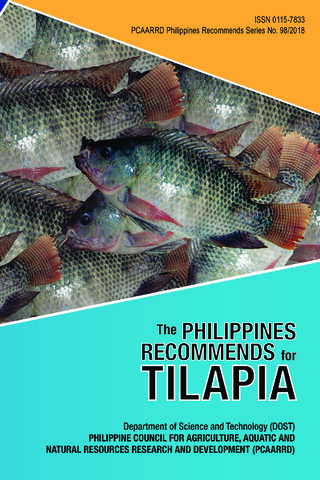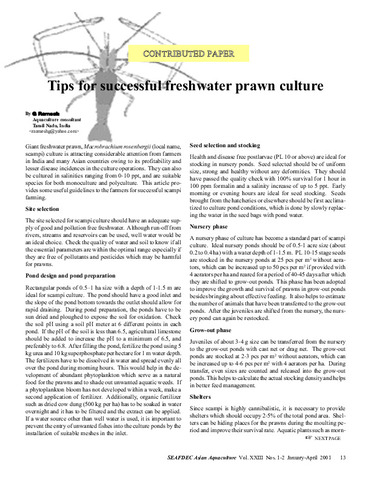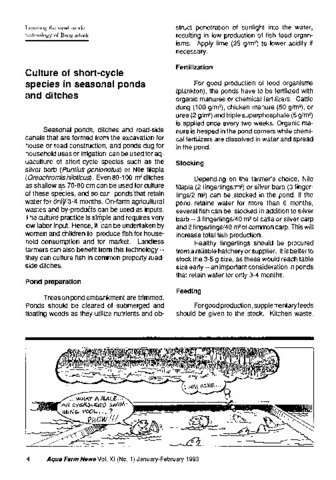Mud crab fattening in ponds
- Global styles
- MLA
- Vancouver
- Elsevier - Harvard
- APA
- Help

閲覧/開く
日付
2001Page views
2,680ASFA keyword
AGROVOC keyword
Taxonomic term
Metadata
アイテムの詳細レコードを表示する
Share
抄録
Two independent experiments on mud crab (Scylla serrata, Portunidae) fattening were conducted simultaneously in 150 m2 ponds for 30 days: Expt. I - monosex male (286 ± 1.2 g) vs. monosex female (267 ± 0.9 g) stocked at 0.5·m-2, and Expt. II - monosex male (338 ± 3.1 g) or female (338 ± 2.8 g) vs. mixed sex (338 ± 3.4 g) stocked at 0.25·m-2. The crabs were fed daily a mixed diet of 75% brown mussel flesh and 25% fish bycatch at 10% of the crab biomass. Intermolt full male crabs weighing ≥ 400 g and roed females ≥ 350 g were partially harvested from the ponds after 20 days of culture using lift net and current method. Results of partial harvest from all treatments in both experiments showed a total yield of 51-55% of the total initial number of stocked crabs (450 crabs in Expt. I, and 338 crabs in Expt. II). From this partial harvest, crabs in Expt. I attained a mean final body weight of 496 g, a specific growth rate (SGR) of 2.75% in males and 432 g, SGR of 2.4% in females. Expt. II gave a mean final body weight of 520 g (males), 484 g (females), and 517 g (mixed sex) and SGR of 1.1, 0.73 and 0.81, respectively. Results of total harvest showed that the overall mean final body weight (372 ± 4.5 g) of monosex male crabs in Expt. I was significantly higher (P < 0.05) than monosex females. However, specific growth rate, carapace length and width, survival, and production were not significantly different (P > 0.05) between monosex males and females. On the other hand, growth and production of monosex crabs in Expt. II was not significantly different (P > 0.05) from mixed sex crabs. However survival of monosex crabs (100%) was significantly higher (P < 0.05) than mixed sex crabs (87 ± 1.88%).
Suggested Citation
Triño, A. T., & Rodriguez, E. M. (2001). Mud crab fattening in ponds. Asian Fisheries Science , 14(2), 211-216. http://hdl.handle.net/10862/1915
Type
ArticleISSN
0116-6514Collections
- Journal Articles [1258]
Related items
Showing items related by title, author, creator and subject.
-
Series: Philippines Recommends Series; No. 98/2018
The Philippines recommends for tilapia
The Tilapia Technical Committee 2017 (DOST-PCAARRD, 2018)Tilapia is one of the most commercially important commodities in fisheries and aquaculture. Although tilapia is relatively easy to propagate and culture, the Philippine tilapia industry needs the necessary boost in the ... -
Tips for successful freshwater prawn culture
Ramesh, G. (Aquaculture Department, Southeast Asian Fisheries Development Center, 2001) -
Culture of short-cycle species in seasonal ponds and ditches
Castaños, Milagros T.; Southeast Asian Fisheries Development Center, Aquaculture Department (Aquaculture Department, Southeast Asian Fisheries Development Center, 1993)





